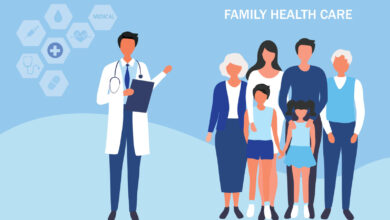TELEMEDICINE: What’s the sense of this trend?

For the last several years, the concept of receiving medical care without actually being in proximity to the doctor has begun to take hold with the public and medical professionals. Medical publications have talked about it, offered suggestions for implementation, and promoted its benefits. TELEMEDICINE, as it’s called, did not really get widespread attention until the current COVID-19, Coronavirus pandemic. Now there’s talk of it becoming “the way of the future” in healthcare delivery. I’m here to tell you, if that ever happens, heaven forbid the consequences.
Telemedicine is a “revolutionary” concept of medical communication using the latest computer technology available to physicians and other providers. It permits a practitioner to provide diagnostic or therapeutic care to a patient from a distant site. It allows direct, private, secure consultation about a patient’s medical needs when face-to-face contact is not possible. It is a “real time” conference between two parties, physician and patient, with the intent to improve the patient’s health. It’s essentially a medical “face time.” I call it “the no-touch house call.”
This variation of Face Time is called “synchronous communication”—it uses a telecommunications link that enables live video interaction between physician and patient. Other forms of Telemedicine are “asynchronous” transmitting lab data, X-ray, CT, MRI, etc. images from a stored data source to a clinician. Radiologists have used this method (Teleradiology) for years to “read xrays” and report their interpretations to treating physicians. ER’s have used this method to access the medical records of patients who come with acute problems or major trauma (Teletrauma).
Because of the high infectivity of the COVID-19 virus, out of safety concerns, a surge in the use of Telemedicine consultations has been seen. Private practice physicians’ offices saw a 65% reduction in patient volumes in late March. I suspect if you had a doctor’s appointment scheduled in the past month it was either cancelled or changed to a telemedicine visit. My wife has had two such appointments in the past week. It’s something people have accepted without hesitation because of the worrisome nature of this virus—its long incubation period, its asymptomatic carrier state, and its uncertain duration of contagion. A cautious attitude is wise. Telemedicine is the ultimate example of the “social distancing” concept.
Medical Economics magazine, the business-side publication for the medical profession, has published many articles on the pros and cons of Telemedicine. My sense is its editorial board favors the practice. In response, I’ve written Letters to the Editor and an article entitled “Doctors are Lazy,” voicing my opinions of this indifferent approach. In an era (outside of the COVID-19 pandemic) when physicians are seen as uncaring, arrogant, and greedy, telemedicine does little to alter that impression. It puts another layer of isolation between doctor and patient, as if the relationship weren’t already one of suspicion and mistrust.
Of course, YOUR doctor is not like that, but many of the others are. That doctor you saw for diarrhea? “What was his name?” “He wasn’t in the room five minutes!” “He had one hand on the door knob the whole time.” “He interrupted me twice!” “I didn’t care for him, and my diarrhea didn’t get better!” Telemedicine impersonalizes the physician-patient encounter exponentially! “At least I didn’t have to shake the guy’s hand!”
If you haven’t already been able to tell, I’m not a fan of this new concept. In situations such as we’re currently experiencing it is necessary and we’re fortunate to have this technology available to us. Why take unnecessary risks when this technology can facilitate the communication the physician and patient need without putting the two parties at risk for acquiring the virus.
Despite my skepticism, studies have shown the lay public approves of telemedicine. Many providers, like myself, feel “the use of a video-based telehealth visit or consult will decrease patient-provider relationships, and be poorly accepted by patients. In fact, research in both the U.S. and worldwide has shown a high acceptance and satisfaction, in general, with telehealth interactions.” Well, there I go again being a dinosaur. A recent survey is forecasting a fivefold increase in telemedicine, and indicates 54% of patients will receive care through telemedicine in the coming weeks. I hope it’s only a temporary solution.
I equate telemedicine to buying something online. How many times have you shopped online, thought you found what you were looking for, but when it arrived it wasn’t what you thought it was. It was too big, too small, the wrong shade of color, or much flimsier construction than it appeared online. It’s not what you thought. The same is true for me with telemedicine—I need to see something first hand, touch it, examine it, and get a feel for what it’s really like before I accept it.
For example, when a patient comes in with a sore throat and a cough, no video technology anywhere is good enough to show me what I can see looking directly at that patient’s throat. Nor is there any technology that will allow me to examine the patient’s neck for enlarged lymph nodes or listen to his lungs. And that annual prostate check or pelvic exam?…..Need I say more?
For routine office follow-up consultations where a limited, or no, exam is needed, this method is fine. For acute problems, though, someone needs to be at the bedside or exam table to lay on hands. For a small town ER staffed by non-physicians, telemedicine communication with an off-site doctor improves the quality of care and can triage patients successfully. But in a big city ER, with major trauma, a team of providers needs to be at the bedside. This technology is useful in that scenario more for accessing the patient’s medical record, lab data, and imaging studies (X-ray, CT, MRI, US) in the course of treating the patient, but not for emergency procedures.
Dr. G’s Opinion: While I completely understand why doctors are currently using telemedicine, I definitely hope it’s only a temporary solution. I have no objection to its long-term use for psychiatric consultations, follow-ups not requiring an examination, or other communications. But the basic components of medical diagnostics are the history and physical examination (H & P). Only half of that model can be accomplished with Telemedicine. It’s impossible to do an adequate physical exam remotely.
Every medical consultation begins with the H & P. From this, the clinician forms his diagnostic Impression (I), and formulates a Plan (P) for diagnostic tests or treatments. Medical educators use this template as a tool for learning, and practicing physicians follow this routine for every patient encounter.
It’s impossible to do most of the parts of a physical exam using Telemedicine. In my “Doctors are Lazy” article I cited how doctors are examining patients while still fully clothed, skipping parts of the exam to save time, or by-passing the physical exam altogether in lieu of the anticipated results of imaging studies (CT, MRI, US, etc). I think this is shoddy medicine. It allows for missed diagnoses or overlooked significant physical findings. It’s being lazy and an example of not doing what you’ve been taught to do. If I were a medical educator I would be very concerned and disappointed that my students were adopting this trend.
I suspect I’m being too much of a purist and “old school.” But I know whenever I cut corners, it usually had regrettable consequences. Medical professionals have the responsibility to use knowledge wisely, respect a patient’s dignity, not prescribe harmful drugs or procedures, and “hold him who has taught you this art as you would your parents.” It means the patient comes first, and it’s our responsibility to do everything to fulfill that obligation. Telemedicine is a huge “corner cut,” and I can see nothing but bad results from it. In our present health crisis environment this “no-touch house call” is acceptable and serves a purpose, but as a permanent practice it’s a bad idea.
References: https://www.medicaleconomics.com/Coronavirus/Coronavirus-survey-finds-patient-volumes-down-likely-stay-down-year.
Freed J, Lowe C, et al. Telemedicine: Is it Really Worth It? A perspective from Evidence and Experience. J Innov Health Inform 2018 Mar 15;25(1):14-18.
Ekeland AE, Bowes A, Flottorp S. Effectiveness of Telemedicine: A Systematic Review of Reviews. Int J Med Inform 2010 Nov;79(11):736-771.
Chaet D, Clearfield R, et al. Ethical Practice in Telehealth and Telemedicine. J Gen Int Med 2017 Oct;32(10):1136-1140.
https://www.aafp.org/news/blogs/freshperspectives/entry/covidtelemedicine.
Sitka N, Paradise S, Shu M. Telehealth in Emergency Medicine: A Primer. Telemedicine Primer 2014 June.
Waller M, Stotter C. Telemedicine: Allergy A Primer Curr Allergy Asthma Rep 2018 Aug 25;18(10):54.
dela Torre-Diaz I, et al. Cost-Utility and Cost-Effectiveness Studies of Telemedicine, Electronic, and Mobile Health Systems in the Literature: A Systematic Review. Telemedicine JE Health 2015 Feb;21(2):81-85.
Bertoncello C, et al. How does it work? Factors Involved in Telemedicine Home-Interventions Effectiveness PLoS One 2018 Nov 15;13(11).




